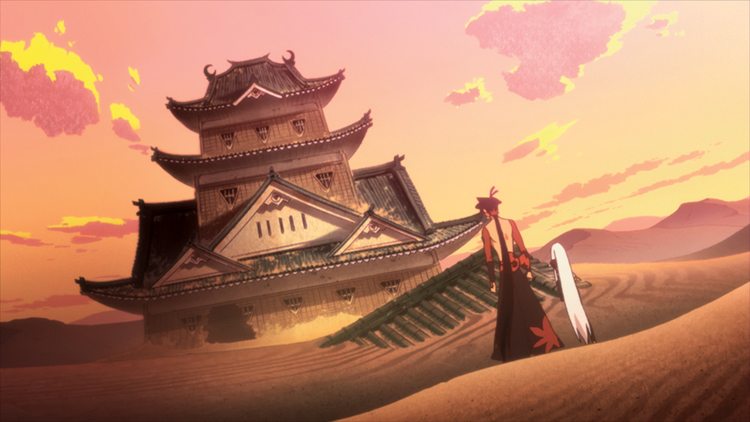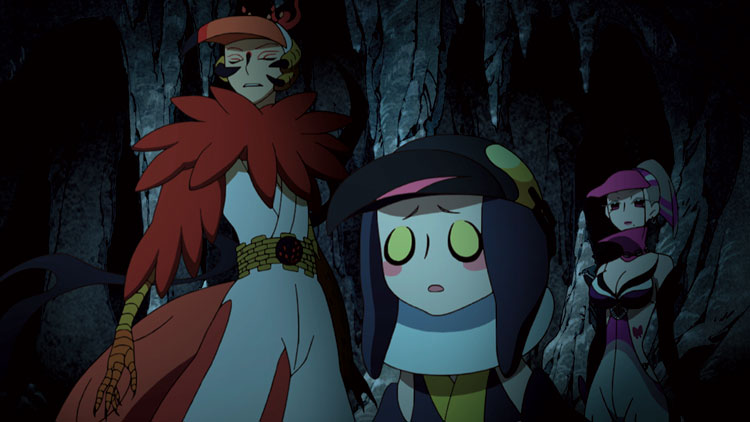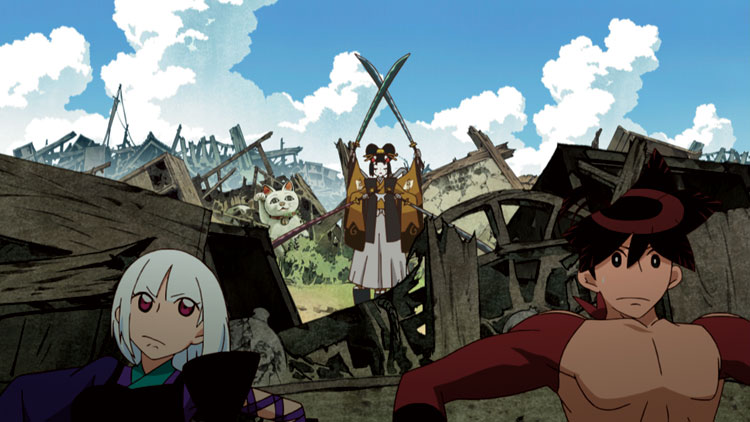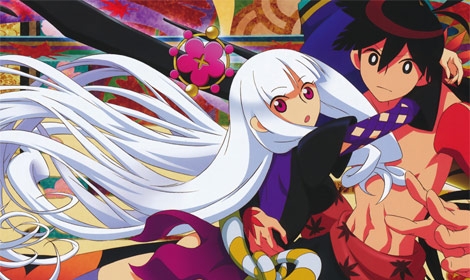Katanagatari is an anime adaption of the light novel written by Niso Ishin and illustrated by Take. White Fox did the anime adaption which aired on January of 2010 and consisted of 12 episodes. One episode was released each month until December 2010, making twelve episodes in total. NIS America has licensed the English release of the series in two premium bundles that contains both the DVD and Bluray copy.
Katanagatari starts in feudal Japan. It focuses on Yasuri Shichika, voiced by Yoshimasa Hosoya, a swordsman that fights without swords. He meets Togame, voiced by Yukari Tamura, who is an ambitious strategist seeking his assistance. Togame seeks to obtain twelve legendary swords for the shogunate, where Shichika’s strength is required. To answer her request, Shichika and Togame explore the rest of Japan to seek the twelve blades.
Katanagatari has some charm to its scenery. The series is based around feudal Japan, so if you look at the scenery, you find a lot of neat and colorful illustration. The scenes in this anime blew my mind because the feudal Japanese are illustrated and drawn eccentrically (in a good way). Many little details can be missed if you are not looking carefully. For example, each forest will have different coloring and tones that matches the story’s mood. If the scene is depressing, the coloring will become dark and gloomy and if the scene is funny, the woods will have a brighter tone to express it. Some temples’ scenes will be drawn in traditional calligraphy style to express the “ye olde” Japan aesthetic, making it really fit the samurai image. Looking at these scenes shows that the animation staff put a lot of effort into illustration to portray more than what is in the text of Katanagatari.

In contrast to these colorful illustrations, nearly all the characters in Katanagatari stand out. Their costumes can be a fusion of modern and feudal clothing, while other clothing will imitate their respective strength in fighting, and some clothing can be as simple as a kimono but is coupled with flamboyant coloring to make the character stand out. This choice of style really made each character enjoyable as you can watch in awe at the unusual appearances of the characters because they stand out from the background, and each costume matches their respective personality.

Illustration and color are not the only things that stand out: the animation-heavy scenes are wonderful. Each action scene and character is animated in a lively way to illustrate Ishin sensei’s world and add a small twist from the animation staff to make the series even more unique. Again, some of the animation scenes in Katanagatari are very eccentric, but in a good way. There are moments where the animation imitates something outside of anime, such as old fashion shoot 'em up games or visual novels. Seeing this new and out-of-the-box thinking really makes things more interesting and revealed more of Nisio Isin's witty writing which can be seen in his other works (e.g. Bakemonogatari, Urooboe Uroboros, etc.)
Another one of my favorite parts of Katanagatari is the dialogue. Nisio Isin is known for parodies, word play, and references to popular terms. He does not fail to show it in this work throughout the twelve episodes. Isin sensei has referred to “Cheerio”(it’ll be explained in the show), emphasized the notorious “death flag”[1], and placed some wordplay that sounds pretty funny despite its serious nature. Recognizing these subtle or obvious hints can bring a sense of accomplishment to those who can recognize them, which gives them more to enjoy from the series other than just the plot.

Although the dialogue is the strength of Nisio Isin, it was also a weakness when it comes to a fifty-minute animation. As the viewers can enjoy the funny dialogue, it can also be tedious to listen to it all when you are expecting a big fight scene. Nisio sensei’s dialogue will try to explain some complicated wordplay, setting, or characters that can delay and truncate action-packed sequence in Katanagatari. As the title is even named “katana”-gatari, we expect to see some sword fighting, but I felt that some of the dialogue ruined the anticipation of fight scenes.
Another compliment I give to Katanagatari is its original soundtrack. Each soundtrack corresponds well to the mood of the story. When it is a tragedy, the music really kicks in to make you sympathize with what is going on. If it is funny, the soundtrack will bring you to the same joy that the characters are experiencing. I also liked how there is variation in the music style, where a few soundtracks will uphold different forms. Some sounds use traditional Japanese music styles such as Enka and Kabuki or use traditional Japanese instruments such as taiko, while other soundtracks will merge Japanese music with hip-hop, making a stylish combination that oddly work in unison.

Overall, I would recommend Katanagatari to anyone who’s looking for an interesting view of feudal Japan. The story isn’t heavily involved in Japanese history or tradition, but it’s a great work of art when it comes to dialogue, scenes and animations.

